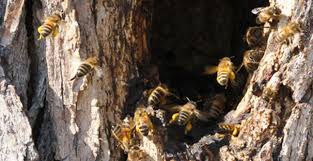Jobs For Bee's Outside The Hive

Bee’s have many jobs those inside the hive and those outside. Without these many jobs the hive would neither thrive or succeed and the colony would die. We talked about the jobs inside the hive in a previous article so now lets look at the jobs bee’s have outside the hive.
 The outside jobs assigned to bees are collector or guard both of which are very important jobs. The collectors have multiple things to finds while out on a busy day. There are collectors for nectar, pollen, propolis and water. The bees collecting nectar ,for honey, and pollen ,for food, store these items in two separate spots. The pollen is kept in “pollen baskets” on their legs and the nectar is carried in their “honey sacks” or “honey stomach”. The honey sack is separate from and in front of its digestive stomach and is used only for storing nectar. In order to retrieve the nectar bees use their long, straw like tube tongues called a proboscis and suck the nectar out. The honey stomach holds almost 70 mg of nectar and when full, it weighs almost as much as the bee does.
The outside jobs assigned to bees are collector or guard both of which are very important jobs. The collectors have multiple things to finds while out on a busy day. There are collectors for nectar, pollen, propolis and water. The bees collecting nectar ,for honey, and pollen ,for food, store these items in two separate spots. The pollen is kept in “pollen baskets” on their legs and the nectar is carried in their “honey sacks” or “honey stomach”. The honey sack is separate from and in front of its digestive stomach and is used only for storing nectar. In order to retrieve the nectar bees use their long, straw like tube tongues called a proboscis and suck the nectar out. The honey stomach holds almost 70 mg of nectar and when full, it weighs almost as much as the bee does.
But this isn’t all they collect, they also collect propolis and water. Propolis is their “bee  glue” which they use to fix cracks or breaks in the hive. In the hive they are unable to remove the sticky substance themselves and so nearby house bees remove the propolis from them. With over 180 different compounds, propolis is the colony’s chemical warfare against various pathogens. It is antiseptic, antifungal, antibiotic, antibacterial, antiviral, and antimicrobial. Bee’s use this substance to protect themselves from microbial invasions.
glue” which they use to fix cracks or breaks in the hive. In the hive they are unable to remove the sticky substance themselves and so nearby house bees remove the propolis from them. With over 180 different compounds, propolis is the colony’s chemical warfare against various pathogens. It is antiseptic, antifungal, antibiotic, antibacterial, antiviral, and antimicrobial. Bee’s use this substance to protect themselves from microbial invasions.
 Water although removed from nectar to make honey is important for the growth and maturation of new larvae. Water collected is transferred to the waiting in-hive workers (nurse bees) through the process of trophallaxis. The nurse bees then combined it with high amounts of pollen and nectar to produce the jelly in their hypopharyngeal glands which is used to feed the larvae. The collected water is also used to keep the hive cool. The water is spread in a thin film atop sealed brood or on the rims of cells containing larvae and eggs. The in-hive workers then fan vigorously, setting up air currents which evaporate the water and cool the interior of the hive on hot summer days.
Water although removed from nectar to make honey is important for the growth and maturation of new larvae. Water collected is transferred to the waiting in-hive workers (nurse bees) through the process of trophallaxis. The nurse bees then combined it with high amounts of pollen and nectar to produce the jelly in their hypopharyngeal glands which is used to feed the larvae. The collected water is also used to keep the hive cool. The water is spread in a thin film atop sealed brood or on the rims of cells containing larvae and eggs. The in-hive workers then fan vigorously, setting up air currents which evaporate the water and cool the interior of the hive on hot summer days.
 Although the collector bees pay an important role in the maintenance and survival of the hive lets not for get about the bees stationed as guards. Guard bees protect the hive, stinging intruders and emitting a pheromone to warn bees inside the hive of impending danger.The guard bees stand at the hive entrance on their back four legs with their front legs raised. They inspect every bee entering the hive. The guard bees can determine if a bee belongs to its colony by the bee’s odor and only members of the hive are allowed in.The guard bees will sting and remove foreign intruders, such as bumble bees, wasps, and yellow jackets. They will also sting and attempt to drive away intruding skunks, raccoons, and beekeepers to keep the hive safe.
Although the collector bees pay an important role in the maintenance and survival of the hive lets not for get about the bees stationed as guards. Guard bees protect the hive, stinging intruders and emitting a pheromone to warn bees inside the hive of impending danger.The guard bees stand at the hive entrance on their back four legs with their front legs raised. They inspect every bee entering the hive. The guard bees can determine if a bee belongs to its colony by the bee’s odor and only members of the hive are allowed in.The guard bees will sting and remove foreign intruders, such as bumble bees, wasps, and yellow jackets. They will also sting and attempt to drive away intruding skunks, raccoons, and beekeepers to keep the hive safe.
Sources
http://peacebeefarm.blogspot.co.nz/2009/08/guard-bees-protect-hive.html
http://www.benefits-of-honey.com/roles-of-bees-in-a-hive.html
https://bigislandbees.com/blogs/bee-blog/14137353-bee-hive-hierarchy-and-activities






